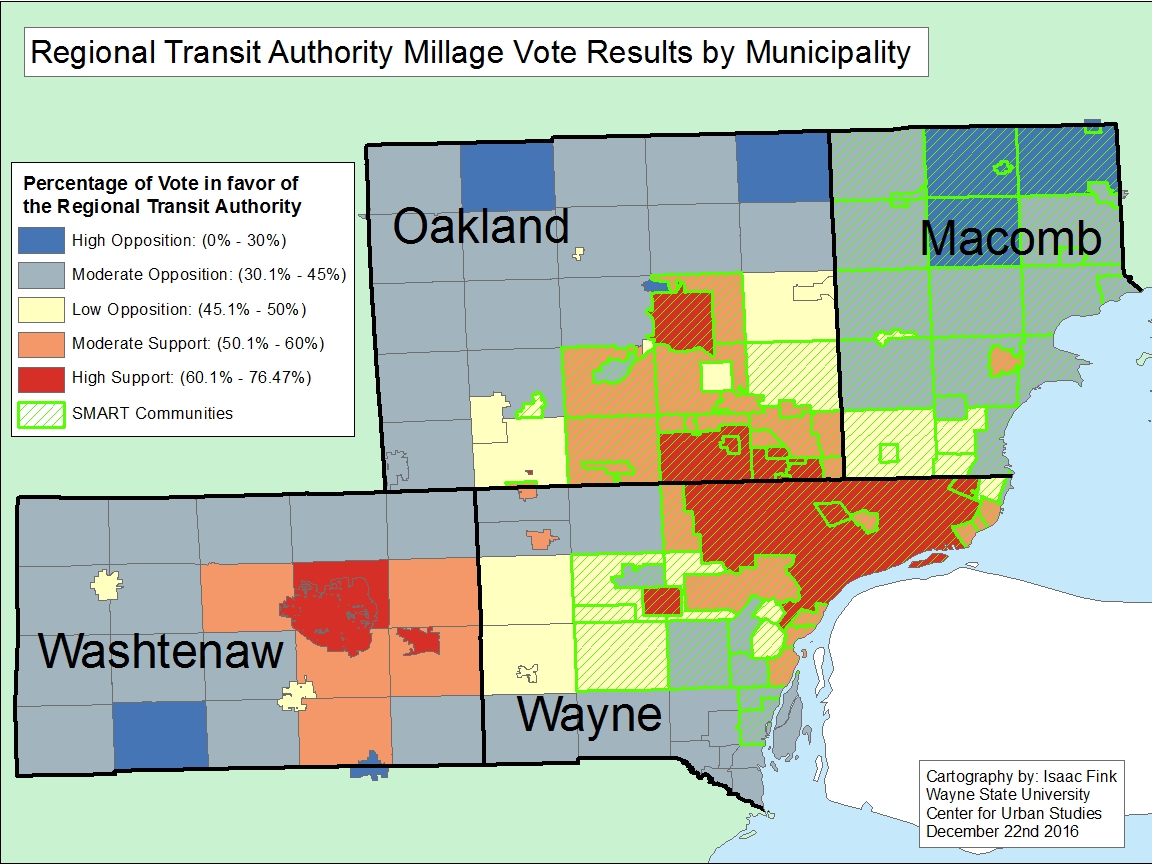In November 2016 the concept of regional transportation in Southeastern Michigan lost again. On the Nov. 8 ballot was a question asking residents of Macomb, Oakland Wayne (including Detroit) and Washtenaw counties if they would fund a 1.2 mill tax (about $120 a year for a homes with a taxable value of $100,000) for 20 years.
If passed, the millage would have created main transportation routes along Woodward, Gratiot and Michigan avenues (some of which would have eventually used Bus Rapid Transit), along with connector lines going east to west throughout Wayne, Oakland, Macomb and Washtenaw counties. However, only Wayne and Washtenaw counties supported the millage overall. In Oakland County the millage fell short of approval by 1,109 votes (50.1 percent of voters voted against it) and in Macomb County the measure failed with 60 percent of voters voting against it.
Currently in Southeastern Michigan, public transportation is fragmented, at best. Parts of Wayne, Oakland and Macomb counties are serviced by the Suburban Mobility Authority of Regional Transit (SMART), a transportation system that was created in 1967. However, in Oakland and Wayne counties communities can opt-out of the system, meaning they do not need to support its funding or have routes accessible in their community. Macomb County, through legislation passed by the County Board of Commissioners, is an entirely opt-in community. This means either the majority of the county supports SMART funding when it goes up for renewal and/or increases or it doesn’t; the county as a whole has historically supported SMART.
Despite Macomb County being completely opt-in for SMART, only one municipality supported the RTA millage in November; it was Mount Clemens-the county seat. According to the Macomb County Clerk’s Department 55 percent of voters in Mount Clemens supported the millage and 45 percent voted against it.
In Oakland County, 23 of the 51 municipalities in the region supported the RTA millage, with the inner-ring suburbs like Ferndale (72% yes), Pleasant Ridge (74% yes) and Huntington Woods (76% percent yes) showing the highest support. Unlike Macomb County, Oakland County is not an entirely “opt-in” community for SMART, meaning individual municipalities decide whether they want to fund/participate in the region’s current form of public transportation. Ferndale, Pleasant Ridge and Huntington Woods all opt-into SMART, as do some of the Oakland County communities that were just above 50 percent of voters supporting the RTA millage; these communities include Bloomfield Township and Birmingham. Troy and Bloomfield Hills are two communities in Oakland County though that participate in SMART but did not approve the RTA millage.
In Wayne County, where there are SMART routes and where the Detroit Department of Transportation (DDOT) operates, communities like Detroit, Hamtramck, Highland Park, Dearborn and Redford Township (which all participate in SMART) voted to approve the RTA millage. However, communities on the western side of the county and a majority of the downriver communities (despite some participating in SMART-like Trenton) did not approve of the transportation millage. Overall, 53 percent of Wayne County voters voted to approve the RTA millage.
Washtenaw County does not participate in SMART (the transit system is limited to Macomb, Oakland and Wayne counties) but it does have the Ann Arbor Transit Authority (AATA). Of those who voted on this measure, 53 percent supported the millage in the county. Overall, eight of the 27 communities in the county supported the millage. However, those with the highest populations (Ann Arbor and Ypsilanti) showed high support for the regional transportation tax.
Despite not having a long-term funding mechanism, the RTA currently operates RefleX, which is a supplemental ride system along Woodward and Gratiot avenues; these services did not eliminate any SMART or DDOT stops/lines. However, the RTA is only funded by the State through Sept. 30, 2017. After that though, its future is uncertain. With the regional transportation millage failing, the RTA is left without a solid funding source and cannot go to the voters with another tax proposal until 2018. According to Public Act 387 of 2012 (which created the RTA), the RTA can receive money through voter approved millage funding and/or an additional fee that may accompany state driver registration fees. Ballot initiatives can only be placed on ballots during presidential or gubernatorial elections.
Members of the RTA Board of Directors or Executive Staff have not publicly stated their future plans or ideas for funding mechanisms. While funding mechanisms would need to be identified, negotiating interlocal agreements between communities that want transit might be an incremental means of supplementing the fragmented systems currently in place. For example, there are no direct public transportation routes between Ann Arbor and Detroit[1] even though Ann Arbor, Detroit and DTW are the most desired routes, according to surveys. Both Wayne and Washtenaw Counties voted for the RTA, so it seems feasible that enterprising public officials in those two counties could negotiate an agreement to move forward on creating services, knowing both that their residents voted for services and that they want those routes.
[1] It might be possible for an ambitious soul to take a bus from Ann Arbor to the Detroit Metropolitan Airport (DTW) and then shift to a SMART bus and transfer to a DDOT bus into Detroit.
[1] It might be possible for an ambitious soul to take a bus from Ann Arbor to the Detroit Metropolitan Airport (DTW) and then shift to a SMART bus and transfer to a DDOT bus into Detroit.

